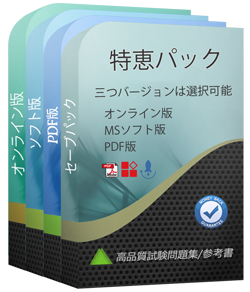あなたのテストエンジンはどのように実行しますか?
あなたのPCにダウンロードしてインストールすると、Snowflake DAA-C01テスト問題を練習し、'練習試験'と '仮想試験'2つの異なるオプションを使用してあなたの質問と回答を確認することができます。
仮想試験 - 時間制限付きに試験問題で自分自身をテストします。
練習試験 - 試験問題を1つ1つレビューし、正解をビューします。
購入後、どれくらいDAA-C01試験参考書を入手できますか?
あなたは5-10分以内にSnowflake DAA-C01試験参考書を付くメールを受信します。そして即時ダウンロードして勉強します。購入後にDAA-C01試験参考書を入手しないなら、すぐにメールでお問い合わせください。
あなたはDAA-C01試験参考書の更新をどのぐらいでリリースしていますか?
すべての試験参考書は常に更新されますが、固定日付には更新されません。弊社の専門チームは、試験のアップデートに十分の注意を払い、彼らは常にそれに応じてDAA-C01試験内容をアップグレードします。
更新されたDAA-C01試験参考書を得ることができ、取得方法?
はい、購入後に1年間の無料アップデートを享受できます。更新があれば、私たちのシステムは更新されたDAA-C01試験参考書をあなたのメールボックスに自動的に送ります。
DAA-C01テストエンジンはどのシステムに適用しますか?
オンラインテストエンジンは、WEBブラウザをベースとしたソフトウェアなので、Windows / Mac / Android / iOSなどをサポートできます。どんな電設備でも使用でき、自己ペースで練習できます。オンラインテストエンジンはオフラインの練習をサポートしていますが、前提条件は初めてインターネットで実行することです。
ソフトテストエンジンは、Java環境で運行するWindowsシステムに適用して、複数のコンピュータにインストールすることができます。
PDF版は、Adobe ReaderやFoxit Reader、Google Docsなどの読書ツールに読むことができます。
割引はありますか?
我々社は顧客にいくつかの割引を提供します。 特恵には制限はありません。 弊社のサイトで定期的にチェックしてクーポンを入手することができます。
Tech4Examはどんな試験参考書を提供していますか?
テストエンジン:DAA-C01試験試験エンジンは、あなた自身のデバイスにダウンロードして運行できます。インタラクティブでシミュレートされた環境でテストを行います。
PDF(テストエンジンのコピー):内容はテストエンジンと同じで、印刷をサポートしています。
返金するポリシーはありますか? 失敗した場合、どうすれば返金できますか?
はい。弊社はあなたが我々の練習問題を使用して試験に合格しないと全額返金を保証します。返金プロセスは非常に簡単です:購入日から60日以内に不合格成績書を弊社に送っていいです。弊社は成績書を確認した後で、返金を行います。お金は7日以内に支払い口座に戻ります。
Snowflake SnowPro Advanced: Data Analyst Certification 認定 DAA-C01 試験問題:
1. You are responsible for loading data into a Snowflake table named 'CUSTOMER DATA' from a series of compressed JSON files located in a Google Cloud Storage (GCS) bucket. The data volume is significant, and the loading process needs to be as efficient as possible. The JSON files are compressed using GZIP, and they contain a field called 'registration date' that should be loaded as a DATE type in Snowflake. However, some files contain records where the 'registration_date' is missing or has an invalid format. Your goal is to load all valid data while skipping any files that contain invalid dates, and log any files that contain invalid records. You want to choose the most efficient approach. Which of the following options represents the best strategy to achieve this?
A) Create a file format object specifying 'TYPE = JSON' and 'COMPRESSION = GZIP. Use a COPY INTO command with a transformation function 'TO DATE(registration_datey and SON ERROR = CONTINUE. Use a validation table to store rejected records.
B) Use Snowpipe with a file format object specifying 'TYPE = JSON' and 'COMPRESSION = GZIP'. Configure error notifications for the pipe and handle errors manually.
C) Create a file format object specifying 'TYPE = JSON' and 'COMPRESSION = GZIP. Use a COPY INTO command with a transformation function 'TRY TO DATE(registration_date)' and 'ON ERROR = SKIP FILE. Implement a separate process to validate the loaded data for NULL 'registration_date' values.
D) create a file format object specifying 'TYPE = JSON' and 'COMPRESSION = GZIP'. Use a COPY INTO command with a transformation function 'TRY Configure the 'CUSTOMER DATA' table with a default value for 'registration_date' and use 'ON ERROR = CONTINUE'.
E) create a file format object specifying 'TYPE = JSON' and 'COMPRESSION = GZIP. Use a COPY INTO command with 'ON_ERROR = SKIP_FILE. Implement a scheduled task to query the COPY HISTORY view to identify any skipped files and manually investigate the errors.
2. You have a table 'CUSTOMER LOCATIONS with customer IDs and their geographical locations in WGS 84 format stored in 'LATITUDE' (FLOAT) and 'LONGITUDE' (FLOAT) columns. You need to create a new table 'CUSTOMER GEOGRAPHY' with a 'LOCATION' column of GEOGRAPHY type derived from these latitude and longitude values. Which of the following statements, used individually or in combination, are necessary and correct to accomplish this?
A) Option E
B) Option B
C) Option D
D) Option C
E) Option A
3. You are tasked with cleaning a dataset containing customer addresses stored in a column named 'ADDRESS RAW'. The addresses are inconsistent, with varying formats, abbreviations, and missing information. You need to standardize the addresses by extracting key components (street address, city, state, zip code) and storing them in separate columns. Which of the following approaches would be MOST effective for this task, considering the complexity and volume of the data, and the need for maintainability?
A) Export the data to a data quality tool, perform address standardization and extraction, and then load the cleaned data back into Snowflake.
B) Develop a UDF (User-Defined Function) in Python that utilizes a dedicated address parsing library (e.g., 'usaddresS) to standardize and extract the address components. Call the UDF in a SQL query to update the table.
C) Create a view with regular expression to parse ADDRESS_RAW.
D) Use a series of regular expressions within SQL queries to parse the 'ADDRESS RAW' column and extract the components. Create separate columns for each component and update the table with the extracted values.
E) Employ Snowflake's built-in string functions (e.g., 'SPLIT, 'TRIM', 'UPPER) in a series of SQL queries to manually parse and standardize the addresses.
4. You are tasked with analyzing website traffic data stored in a Snowflake table named 'page_views'. The table has columns 'user_id' (INT), 'page_url (VARCHAR), and 'view_time' (TIMESTAMP N T Z). You need to identify users who are likely bots based on an unusually high number of page views within a short period. Specifically, you want to flag users who have more than 100 page views within any 5-minute window Which of the following queries is the MOST efficient and accurate way to achieve this?
A) 
B) 
C) 
D) 
E) 
5. You are responsible for collecting server log data from multiple geographically distributed data centers. The logs are generated at a high velocity and variety of formats (JSON, CSV, plain text). The requirement is to ensure minimal data loss and efficient ingestion into Snowflake, while also handling potential schema variations across different log sources. Which of the following is the MOST robust and scalable solution, considering potential schema drift and data volume?
A) Use a centralized file server to collect logs and then use Snowpipe with schema detection enabled on a single variant column in Snowflake.
B) Utilize a message queue (e.g., Kafka) to collect logs from all data centers and create an external table pointing to the message queue. Use Snowflake streams to ingest the data from the message queue into Snowflake.
C) Configure each data center to directly stream logs to Snowflake using the Snowflake JDBC driver.
D) Employ a distributed log aggregation system (e.g., Fluentd or Logstash) to standardize the log format and then use Snowpipe to ingest the data into Snowflake.
E) Write a custom Python script to pull logs from each data center, transform them into a consistent CSV format, and then upload the CSV files to Snowflake using Snowpipe.
質問と回答:
| 質問 # 1 正解: D | 質問 # 2 正解: C | 質問 # 3 正解: B | 質問 # 4 正解: D | 質問 # 5 正解: D |


 弊社は製品に自信を持っており、面倒な製品を提供していません。
弊社は製品に自信を持っており、面倒な製品を提供していません。



 -Shimatani
-Shimatani

